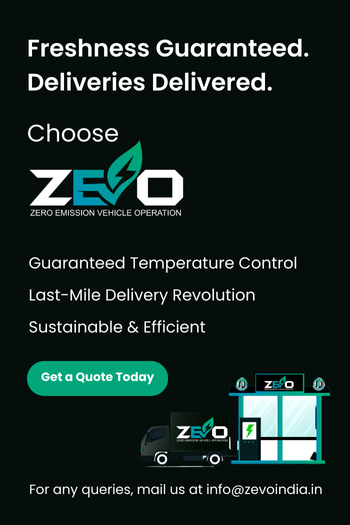The Challenge of Refrigerated Last-Mile Delivery (and How to Keep it Cool)

Akshay Sharma
CEO's Office @ZEVO
Imagine you’re rushing home after a long day, starving and craving a healthy meal. You open the fridge to find…well, let’s just say it wouldn’t win any freshness awards.
Sound familiar?
Thankfully, online grocery delivery services are there to save the day (and dinner!). But have you ever stopped to wonder how that carton of milk or that package of salmon arrives perfectly chilled, even on a scorching summer day?
The secret lies in a complex logistical feat called “refrigerated last-mile delivery.” This crucial process ensures that your groceries – and any other temperature-sensitive goodies you order online, like medicine or even pet food – stay fresh and safe on their journey from the warehouse to your doorstep.
So, grab a cold drink (delivered fresh, of course!), and let’s dive into the world of keeping things cool in last-mile delivery. This isn’t just about convenience; it’s about ensuring the quality and safety of everything you get delivered, straight to your fridge.
The Balancing Act: Maintaining Temperature Control
Alright, so we’ve established this last-mile delivery for cold stuff is pretty cool. But here’s the thing: keeping things frosty isn’t a one-size-fits-all situation. That tub of ice cream you desperately need for a movie night?
Needs to stay rock-solid, probably around -18°C. But those veggies and fruits for your health kick? They’re happier in a more moderate fridge-like environment, somewhere around 4°C.
Think about it like that perfect glass of beer. You wouldn’t want your IPA lukewarm, right? Same goes for your groceries. The wrong temperature can not only ruin the taste, but for some things, it can be a serious health hazard.
Did you know that according to the CDC, improper food temperature control is a major contributing factor to foodborne illnesses, leading to millions of cases and thousands of hospitalizations every year in the US alone?
Imagine that salmon you ordered online for a fancy dinner – if it gets stuck in traffic for hours or bounces around in a hot truck making a million stops, well, let’s just say dinner plans might need a quick change, and you might be facing an unpleasant few days.
That’s why keeping that cool chain unbroken is critical. But let’s be honest, traffic jams and multiple deliveries are a reality. So, how do we keep things from turning into a science experiment gone wrong?
Well, there are a few tricks up our sleeves, like strategically planned routes to minimize travel time and top-notch refrigerated trucks with serious insulation to keep the heat at bay. We’ll dive deeper into those battle plans later, but for now, just know there’s a whole team working behind the scenes to ensure your groceries (and ice cream) arrive fresh and ready to enjoy.
The Maze Master: Optimizing Delivery Routes
So, picture this: a delivery truck overflowing with fresh groceries – juicy strawberries, crisp lettuce, and that perfectly marbled ribeye you ordered for dinner. Now, imagine this truck weaving through city traffic, making stops all over town with no real plan.
Sounds like a recipe for disaster, right? That perfectly chilled ribeye could end up room temperature by the time it reaches your doorstep, and those strawberries? Well, let’s just say they might be better suited for a science project than a fruit salad.
This is where the magic of route optimization comes in. You see, in the world of refrigerated last-mile delivery, planning the most efficient route isn’t just about saving time and gas (although those are important too).
It’s about keeping everything nice and cool. Think of it like navigating a maze, but instead of walls, you’re dodging traffic jams and minimizing the time those precious groceries spend outside the fridge.
Optimizing Routes with Technology:
Here’s where technology steps up its game. Fancy delivery management software helps us map out the most efficient routes possible. This software takes into account all sorts of things:
- Traffic patterns throughout the day: You wouldn’t want to get stuck in rush hour with a truck full of perishables, would you?
- Product types on board: Maybe that ice cream needs to get to your house first, while the milk can handle a slightly longer journey.
A Real-Life Example:
Take a grocery delivery company like “Fresher Deliveries.” They implemented a new route optimization software program that considers real-time traffic data and product types. The results? A 20% reduction in average delivery times and a significant decrease in spoilage rates. This translates to fresher groceries for customers and less waste for the company – a win-win situation.
By grouping deliveries by location and using smart software to avoid traffic woes, we can create a smooth, efficient route that keeps your groceries spending as little time as possible basking in the sun. Basically, it’s all about getting those fresh goods from the warehouse to your kitchen in the shortest amount of time, ensuring everything arrives looking (and tasting) just as good as it left.
Imagine biting into that juicy strawberry – bursting with flavor, just like it was picked. That’s the promise of efficient refrigerated last-mile delivery: fresh food, conveniently delivered, without sacrificing quality. Pretty cool, huh?
The Unexpected Turn: Dealing with Delays
Life, as they say, throws curveballs. And in the world of refrigerated last-mile delivery, those curveballs can come in the form of unexpected delays.
Imagine you’ve ordered some life-saving medication that needs to stay cool, and BAM! A sudden downpour throws the city into a traffic nightmare. With every tick of the clock and every inch the car ahead of you crawls, that medication starts to risk spoiling. Not exactly the outcome you were hoping for, right?
These unexpected delays, whether it’s a fender bender or a surprise snowstorm, can wreak havoc on maintaining that all-important cool chain. The longer things sit outside their ideal temperature range, the higher the chance they spoil or become unsafe to consume.
So, how do we navigate these unexpected turns? Well, for starters, communication is key. Delivery companies are getting pretty good at keeping you in the loop. Real-time updates on your phone can let you know if your groceries might be running a bit behind schedule due to traffic.
But that’s not all. We also have some contingency plans in place to keep things cool even when things get hot (literally or figuratively). This could involve having backup vehicles ready to roll in case of breakdowns.
Some companies are even piloting programs with designated cold storage lockers strategically placed throughout the city. Think of them as mini-refrigerator pit stops for deliveries caught in a jam. These lockers can be remotely monitored and accessed by drivers to ensure medications or other temperature-sensitive items stay safe until delivery can resume.
By having these plans in place, we can minimize the impact of delays and ensure your groceries (or medication) stay fresh, no matter what life throws our way.
The Future is Cool: New Technologies and Sustainability
The world of refrigerated last-mile delivery is constantly evolving, and new technologies are popping up like mushrooms after a spring rain. One particularly cool (pun intended) innovation is smart packaging.
Imagine boxes or containers with built-in temperature sensors and real-time monitoring. These sensors can then send information to your phone, so you can see with your own eyes that your fancy ice cream is staying perfectly frozen. Pretty neat, right?
This kind of technology has the potential to be a game-changer. By constantly monitoring temperature, we can ensure the quality and safety of products, reducing the risk of spoilage and foodborne illness. Think about it – no more wondering if that carton of milk has been sweating it out in the back of a hot truck.
But here at last-mile delivery HQ, we’re not just focused on keeping things frosty, we’re also striving to be eco-friendly. Let’s face it, all those refrigerated trucks burning fuel aren’t exactly doing wonders for the environment.
That’s why we’re exploring sustainable solutions like electric vehicles for last-mile deliveries. Imagine a fleet of quiet, zero-emission trucks zipping around town, delivering your groceries without leaving a carbon footprint. Pretty cool, right?
We’re also looking at alternative fuels like bio-fuels derived from plants or even recycled materials. By using these options, we can reduce our reliance on traditional diesel and lessen our environmental impact.
The future of refrigerated last-mile delivery is looking bright – it’s all about keeping things fresh, ensuring quality, and doing our part to keep the planet healthy. So, the next time you fire up that grocery delivery app, remember the complex (but fascinating!) world of logistics that goes into getting them to your doorstep, nice and cold.

Share this Article
Subscribe to our newsletter
Be the first to receive exclusive offers and the latest news on our products and services directly in your inbox.
